Learn how to paint an easy watercolor beach sunset step-by-step in this online art lesson. Paint along in this easy-to-follow online art tutorial.
The reflecting sun setting over the ocean, lake, or river is one of nature’s true exhibitions. Painting a beautiful sunset is broken down into easy simple to follow steps for beginners.
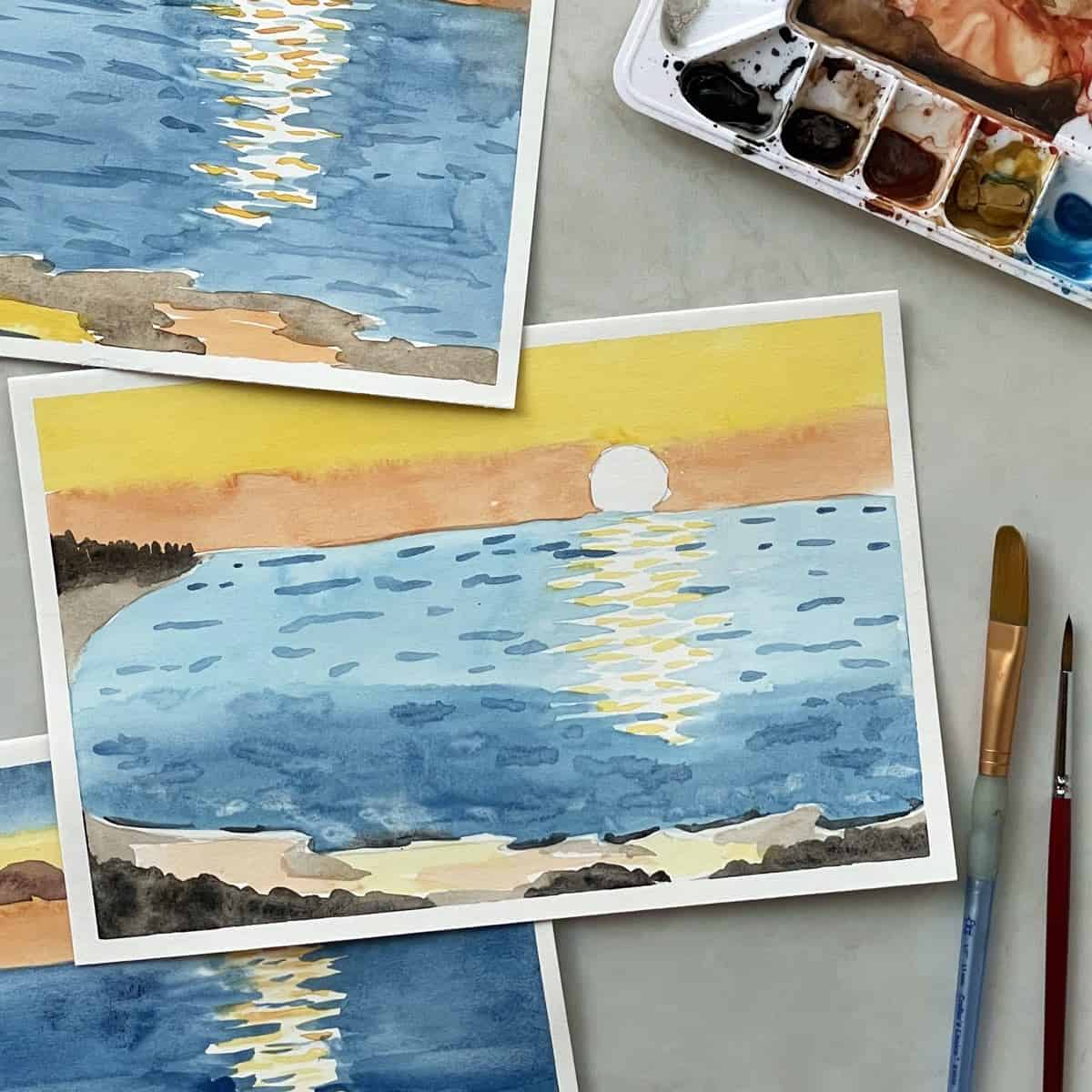
Jump to:
Have you ever seen an amazing sunset and wanted to capture its essence and likeness in a work go art? Using simple materials, just watercolors and brushes, anyone can turn a blank piece of paper into a stunning work of art.
With just a little practice, using watercolors will become easy. So relax, sit back, and paint along with me in this video art class.
Materials
- Pencil
- Paintbrushes
- Watercolor paper - I am using 140 lb. Strathmore Vision cold press watercolor paper cut down into a 6 x 9-inch piece.
- Watercolor paint - tube watercolor paint on a pallet or a box kit of watercolor paints such as Crayola or Prang. Avoid cheap or off-brand watercolor boxes because the colors will not be very vibrant. Don’t worry if you don’t have the same colors, you can use whatever you have on hand. I use:
- Cadmium Yellow
- Cadmium Red Light
- Cerulean Blue
- Prussian Blue
- Burnt Sienna
- Black
Video Tutorial
Transcript
Read TranscriptArt Lesson
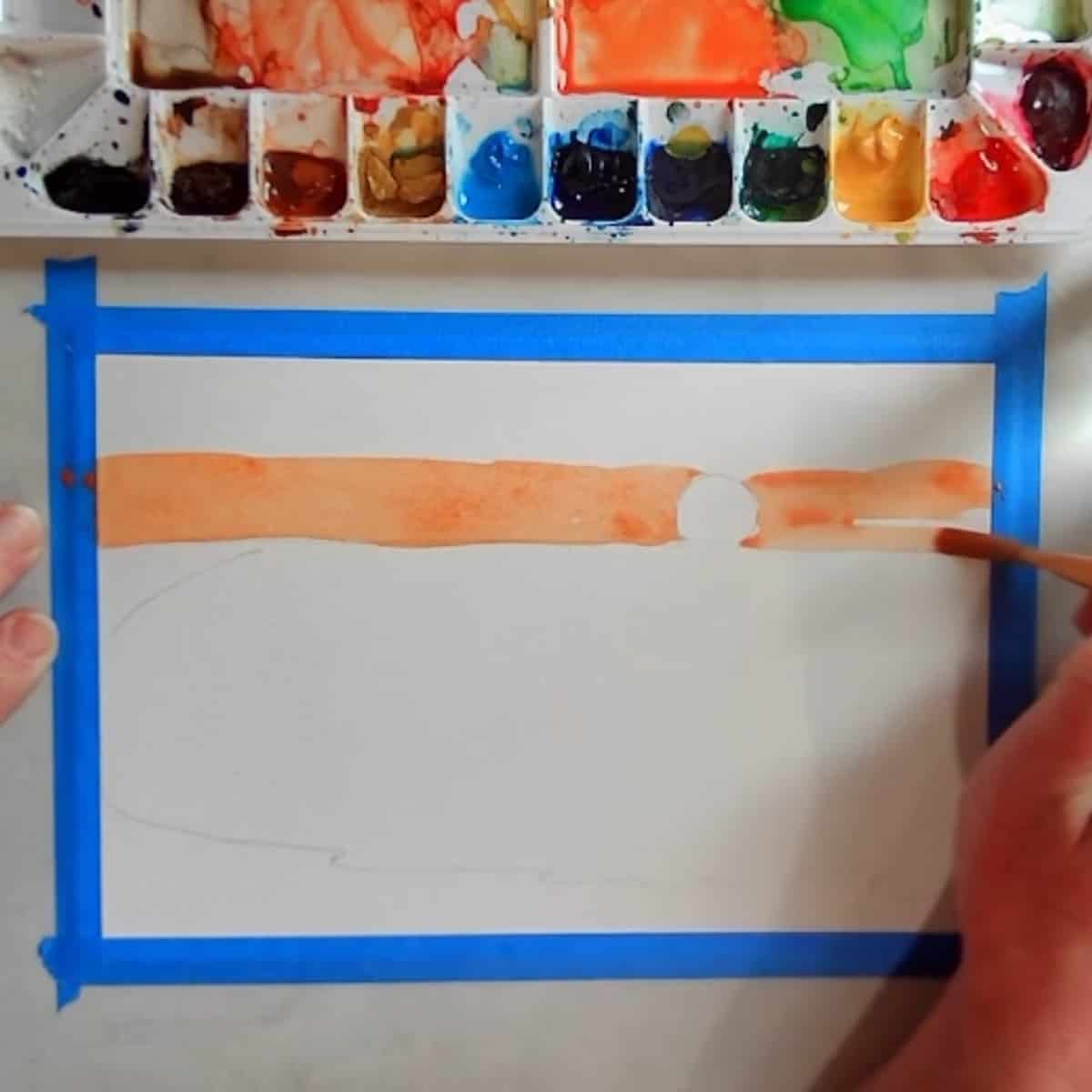
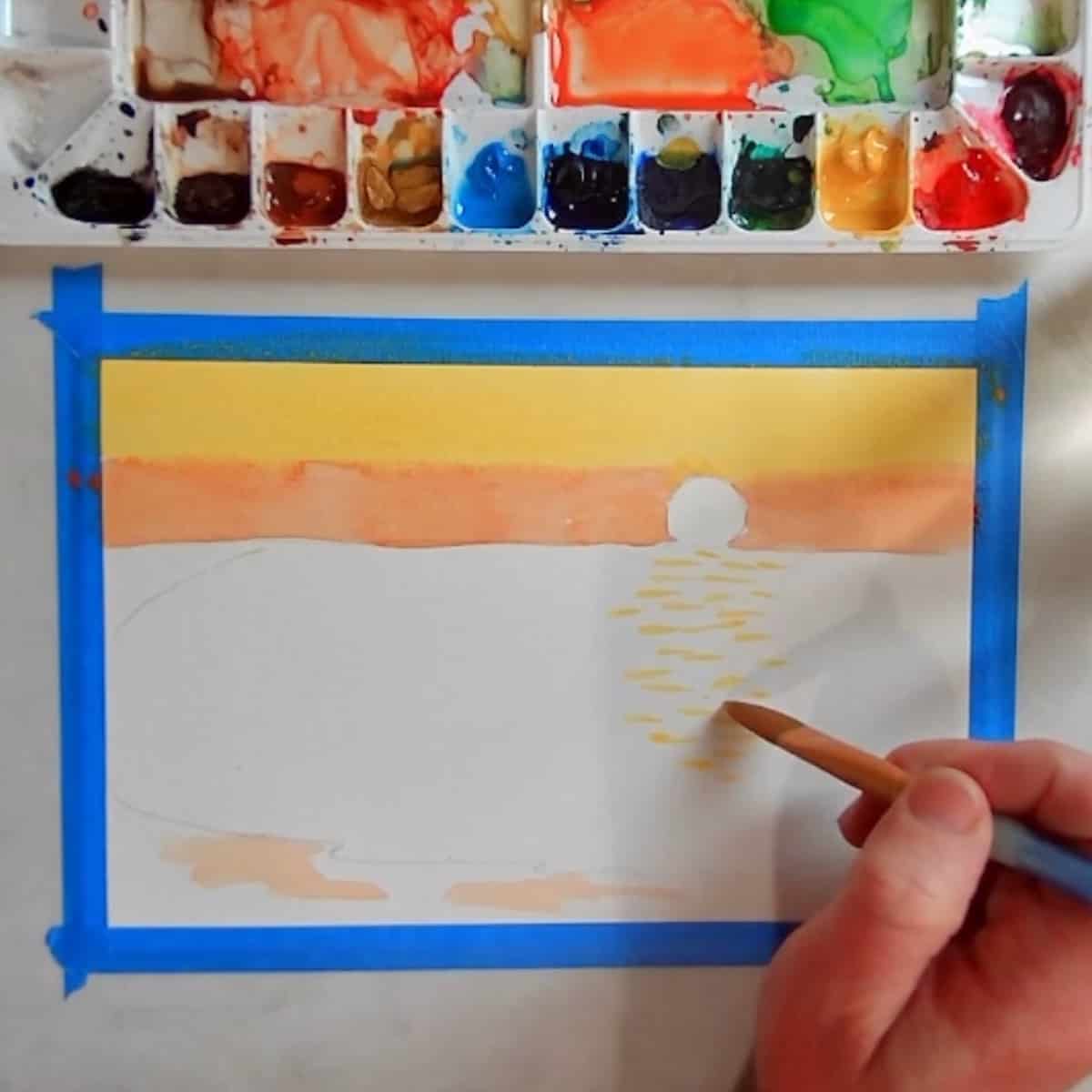
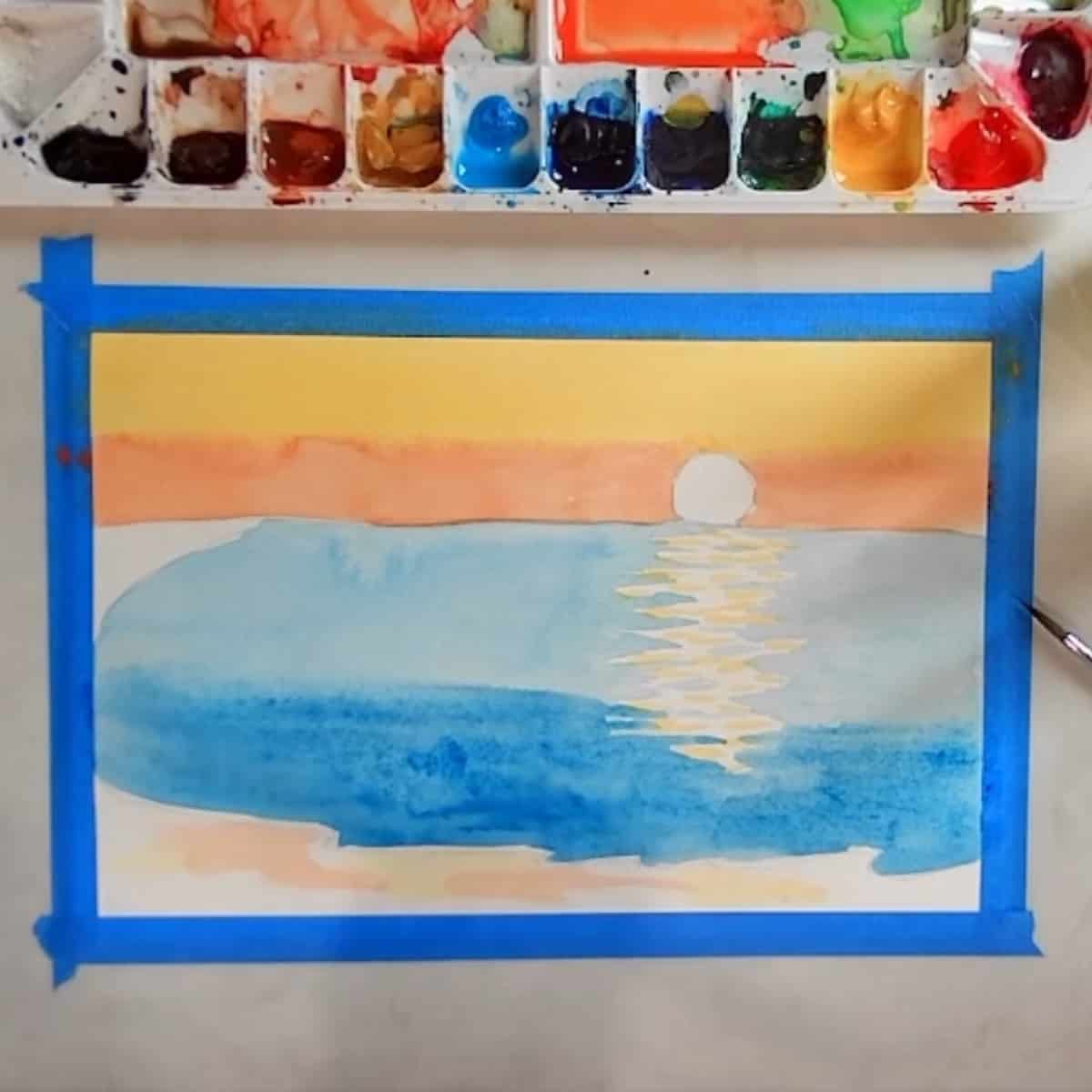
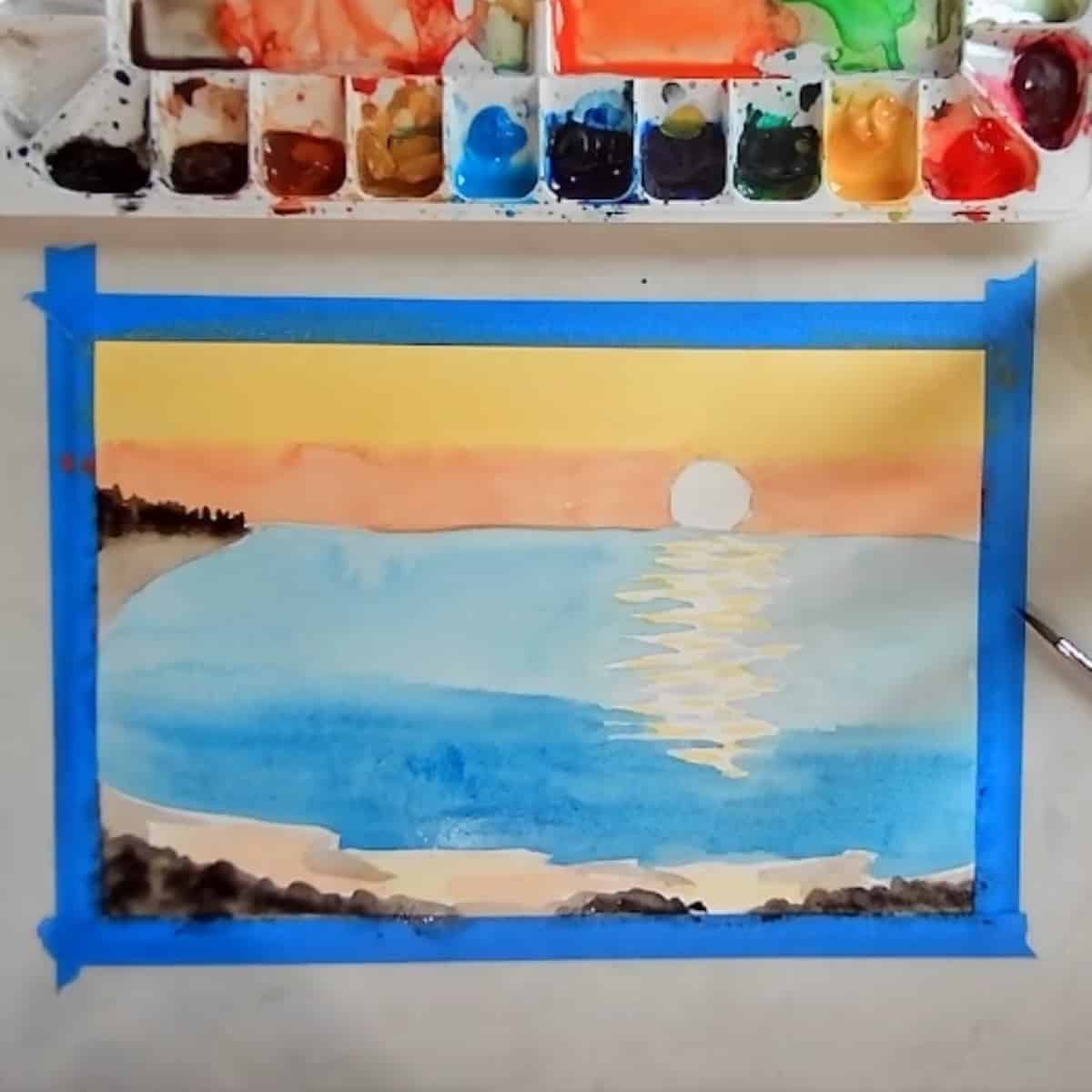
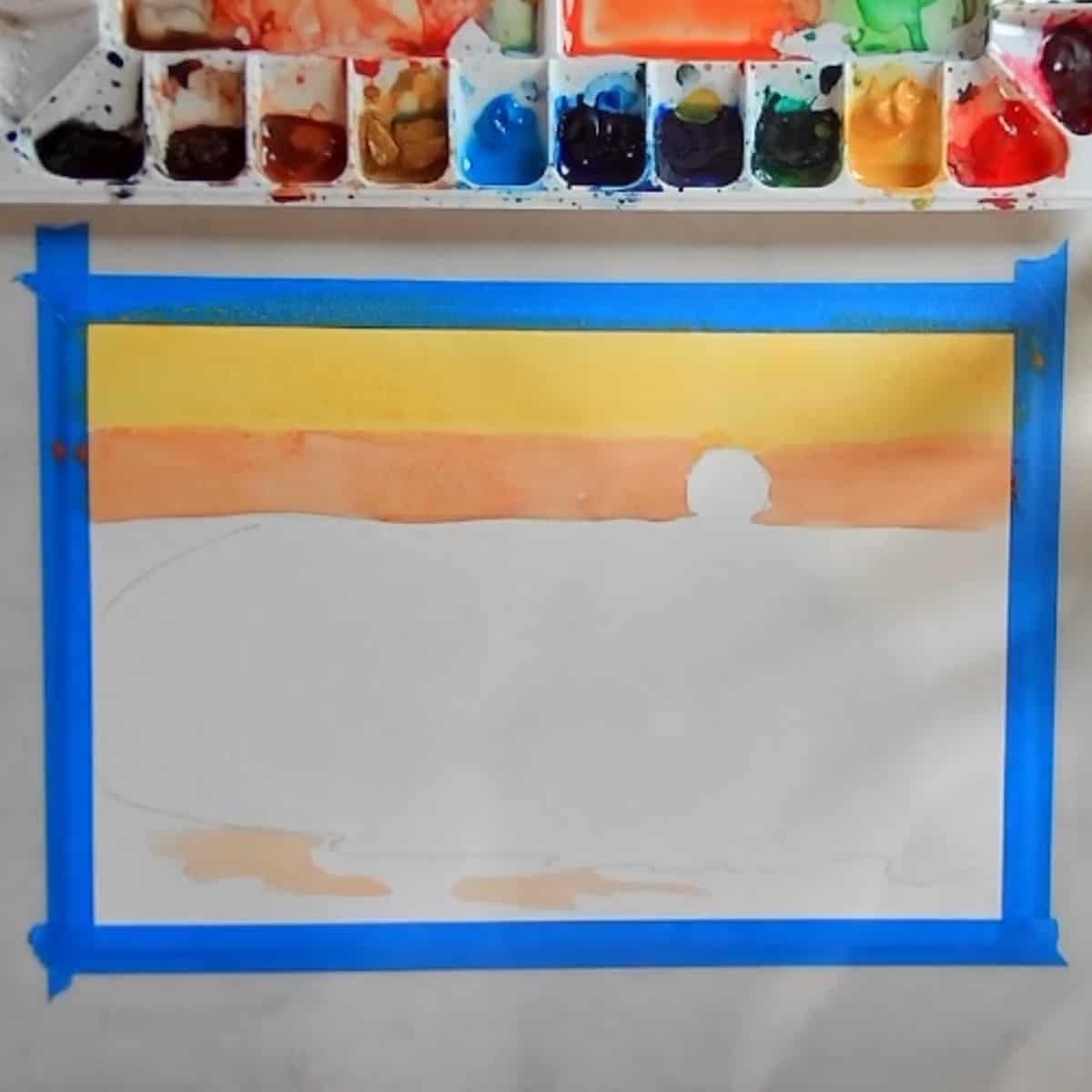

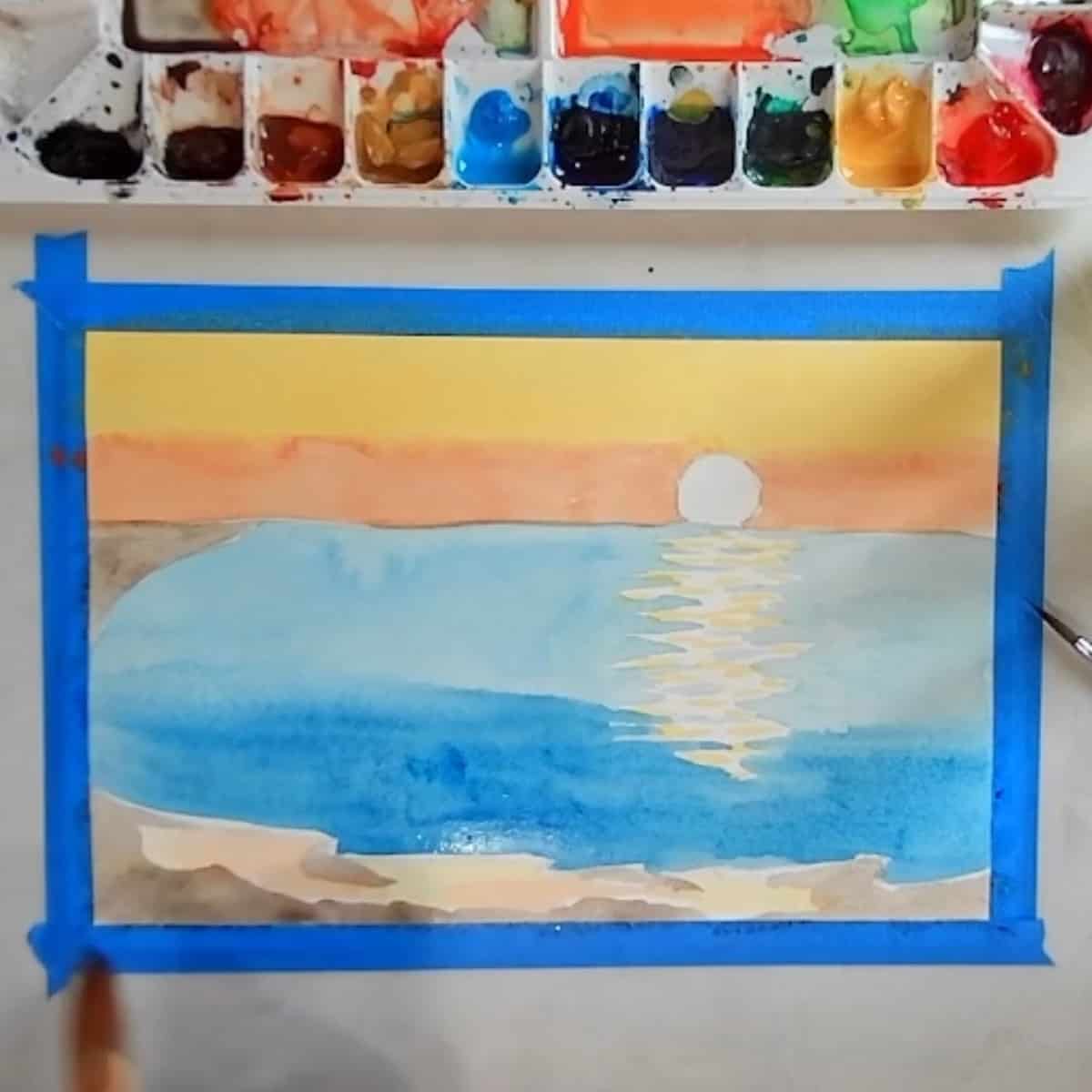

- Prepare the paint and paper
- Add a few drops of water to each of the colors you will use.
- Tape down your watercolor with blue painter’s tape. For small projects, this is usually enough to hold the paper down. Leave the tape on until your project is completely dry.
- Lightly sketch in the horizon line, a small circle for the sun, and the edge of the beach swooping from the background to the foreground.
- Watercolor the sky
- Mix orange paint by combining red and yellow together. Paint this orange next to the horizon line. Leave the sun white, painting around it.
- Dilute the orange paint on the brush and add a few light orange reflections on the beach.
- Paint a strip of yellow above the orange, allowing them to blend together slightly as they dry.
- Add more water to the yellow on the brush and paint several light yellow reflections on the sand, near the orange reflections.
- Paint small horizontal lines of yellow paint in the area below the sun. This light reflecting on the water extends from the sun towards the beach.
- Paint the Water
- Paint in the water with cerulean blue (or another blue if you like).
- Start on one side of the water and paint up to the edge of the yellow lines. Then pull the blue paint in small horizontal lines from the water into the sunny reflection area.
- The blue lines go in the middle of the yellow lines, making sure to leave some white in between.
- Continue painting cerulean blue in the water area down toward the beach and around the front of the reflected sun. Leave a small line of white paper between the sand of the beach and the blue of the water.
- Then repeat the small blue lines on the other side.
- Add some Prussian blue paint to the foreground of the water. Dark colors tend to come toward the view so this helps add depth to the painting.
- Brush in the beach
- Paint in the sand on the beach with black mixed with burnt Sienna. Leave a few areas of white.
- Use this same color to paint the triangle of sand in the background.
- Add a few dabs of black paint in the beach in the foreground. Paint small black lines where the sand meets the horizon line to indicate a few trees in the distance.
- Using a small paintbrush, dilute the black paint and make small strokes on the edge of the water where it meets the beach. Make the lines irregular and broken.
- These lines should dry to medium gray and make the waves appear to have a little bit of volume as they roll onto the sand. Leave the white line of paper between the water and the sand.
- Lastly, add a few lines of dark blue paint in the water for texture.
Variations
- Add different colors to the sky, such as blue, red, purple, or pink.
- While painting the sky you could paint in a few clouds in complementary colors. If you want clouds in contrasting colors, allow the sky to dry completely first.
- Add small indications of people on the sand in the distance.
- To add a boat in the water, sketch it out first and leave it white when you paint the water. After the water is completely dry then paint in the details of the boat.
- For more practice, paint a sunset from life or a photo.
Tips and tricks
- In this beach painting keep your strokes nice and loose.
- Do not add any paint to white areas, Just leave it the color of the paper.
- If you make a mistake you can usually remove the paint with a clean wet paint brush with a lifting motion. You could also try a paper towel folded to a small point.
- Remember that watercolor paint will dry slightly lighter in color than it is when it is wet.
- Keep practicing your painting skills! Watercolor can be difficult to learn so continue to practice this beach sunset and other lessons.
Direction Card
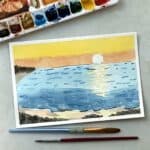
How to Paint an Easy Watercolor Beach Sunset Step-by-step
Equipment
- Pencil
- Paintbrushes
- Watercolor paper - I am using 140 lb. Strathmore Vision cold press watercolor paper cut down into a 6 x 9-inch piece.
- Watercolor paint - tube watercolor paint on a pallet or a box kit of watercolor paints such as Crayola or Prang. I use: cadmium yellow, cadmium red light, cerulean Blue, Prussian blue, burnt umber, burnt Sienna and black Avoid cheap or off brand watercolor boxes because the colors will not be very vibrant.
Instructions
Prepare the paint and paper
- Add a few drops of water to each of the colors you will use.
- Tape down your watercolor with blue painter’s tape. For small projects, this is usually enough to hold the paper down. Leave the tape on until your project is completely dry.
- Lightly sketch in the horizon line, a small circle for the sun, and the edge of the beach swooping from the background to the foreground.
Watercolor the sky
- Mix orange paint by combining red and yellow together. Paint this orange next to the horizon line. Leave the sun white, painting around it.
- Dilute the orange paint on the brush and add a few light orange reflections on the beach.
- Paint a strip of yellow above the orange, allowing them to blend together slightly as they dry.
- Add more water to the yellow on the brush and paint several light yellow reflections on the sand, near the orange reflections.
- Paint small horizontal lines of yellow paint in the area below the sun. This light reflecting on the water extends from the sun towards the beach.
Paint the water
- Paint in the water with cerulean blue (or another blue if you like).
- Start on one side of the water and paint up to the edge of the yellow lines. Then pull the blue paint in small horizontal lines from the water into the sunny reflection area.
- The blue lines go in the middle of the yellow lines, making sure to leave some white in between.
- Continue painting cerulean blue in the water area down toward the beach and around the front of the reflected sun. Leave a small line of white paper between the sand of the beach and the blue of the water.
- Then repeat the small blue lines on the other side.
- Add some Prussian blue paint to the foreground of the water. Dark colors tend to come toward the view so this helps add depth to the painting.
Brush in the beach
- Paint in the sand on the beach with black mixed with burnt Sienna. Leave a few areas of white.
- Use this same color to paint the triangle of sand in the background.
- Add a few dabs of black paint in the beach in the foreground. Paint small black vertical lines where the sand meets the horizon line to indicate a few trees in the distance.
- Using a small paintbrush, add a bit more water to the black paint and make small strokes on the edge of the water where it meets the beach. Make the lines irregular and broken.
- These lines should dry to medium gray and make the waves appear to have a little bit of volume as they roll onto the sand. Leave the white line of paper between the water and the sand.
- Lastly, add a few lines of dark blue paint in the water for texture.
Notes
Lesson Downloads
Feel free to use the template if you don't want to draw it by hand. Simply print out the template the size of your watercolor paper and then transfer it using graphite paper.
What to Do with Your Painting
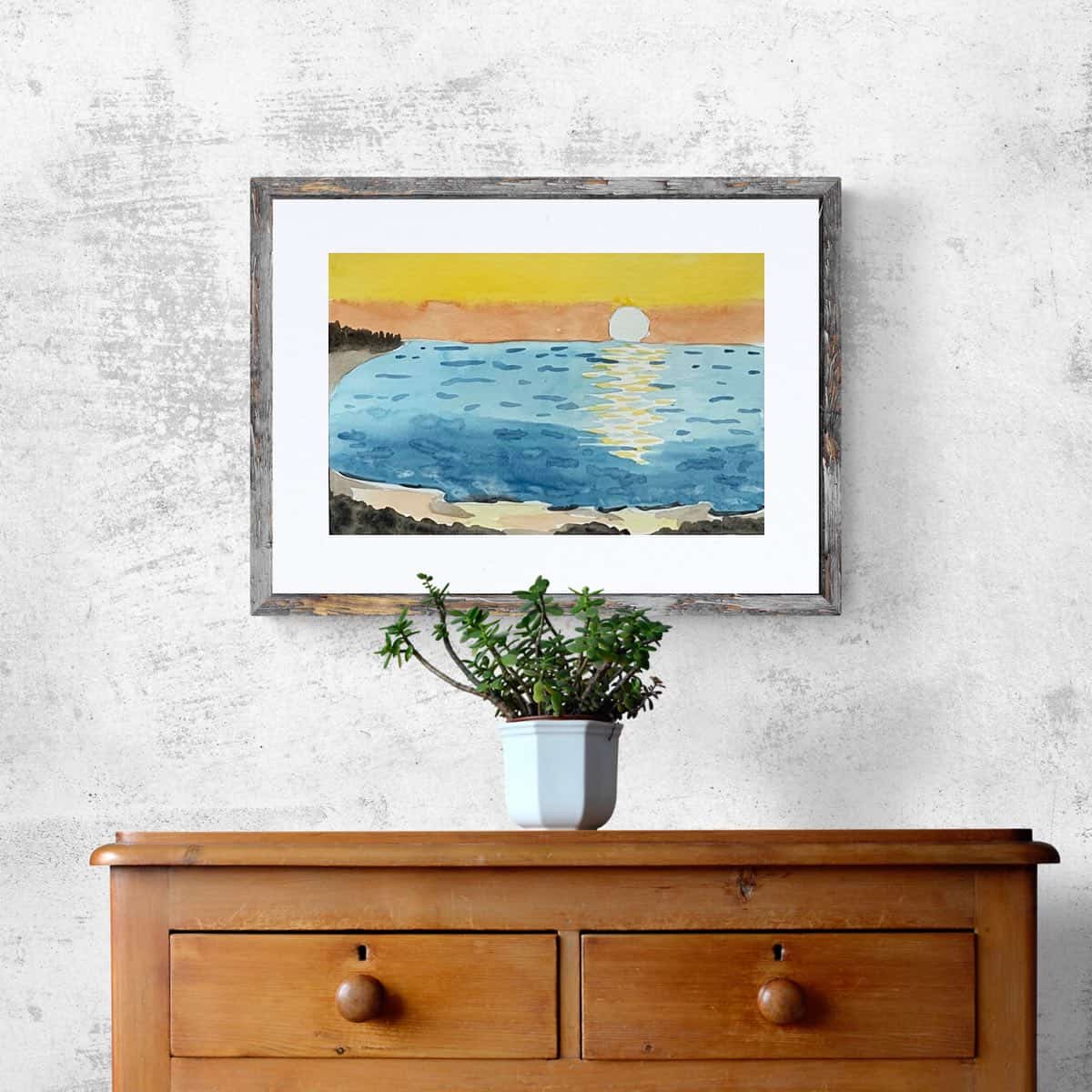
Frame your painting and decorate your home with your beach sunset. What a beautiful decoration in any room!
You could also add it to your, portfolio, a compilation of your completed paintings, drawings, sketches, and art projects.
Your watercolor would also make a wonderful homemade gift. Hand-made art makes a wonderful and thoughtful present.
Frequently Asked Questions
Using loose strokes, paint in some of the same colors from the sky. Dilute the colors with some clean water so it looks like the color is reflecting off the sand.
Paint in the other areas with grey or light brown. Leave a few small areas of white.
Orange and yellow are often great colors when painting a beach sunset. You could also add red or purple. Experiment and choose your favorite.
If you choose to add blue to your sunset be aware that blue mixed with yellow will turn green. It is best to leave a hairline width space between the blue and the other sunset colors. After the colors have dried, use water on a clean brush and lightly blend the areas where they meet.
Paint small horizontal lines of yellow paint in the area below the sun. This light reflecting on the water extends from the sun towards the beach. Paint in the water with blue (or another cool color).
Start on one side of the water and paint up to the edge of the yellow lines. Then pull the blue paint in small horizontal lines from the water into the sunny reflection area. The blue lines go in the middle of the yellow lines, making sure to leave some white in between.

You also might like
- Watercolor an Easy Lake Scene with Trees
- How to Paint Reflections on Water
- Sketch an Easy Mountain Landscape
- Draw a Simple Seascape Ocean Scene
- Watercolor Paint Easy Mountains in 8 Different Ways
Please leave your questions, comments, and ratings below!





Leave a Reply